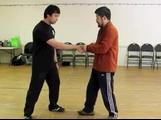 I believe that what happens to a connected person’s body when being pushed can be understood by understanding how a trampoline works.
I believe that what happens to a connected person’s body when being pushed can be understood by understanding how a trampoline works.
When a person jumps onto a properly connected and tightened trampoline, a stretch inward is produced at the point of contact and the trampoline appears to retreat. However, this is externally deceiving because actually the energy of the oncoming force is being evenly dispersed throughout the springs and into the solid foundations of the external structure (which are fastened to solid ground). When the energy has been evenly spread throughout the structure, the impact is softened and neutralized. When it reaches its peak tension, the energy turns over and is instantly pushed back to the center. Finally, the energy is released through the very location where it was initially applied and the person is thrown back into the air.
 I believe this explains why sometimes people seem to “bounce out” when pushing with more advanced practitioners. When someone is properly connected due to correct stretching and spiraling, the energy of the opponent’s push is evenly distributed throughout the multitude of connected tendons running throughout the body. These are supported by the solid skeletal structure and rooted to the ground by the feet. This greatly diffuses the power of the blow and collects its energy so that it can be sprung back out at a much higher velocity. This is why practitioners often don’t feel like they did anything to make the opponent “bounce out” and why the people who are bounced out rarely realize what happened or where the energy came from. Basically, the more power a person uses to push into a connected person, the more devastating the result will be.
I believe this explains why sometimes people seem to “bounce out” when pushing with more advanced practitioners. When someone is properly connected due to correct stretching and spiraling, the energy of the opponent’s push is evenly distributed throughout the multitude of connected tendons running throughout the body. These are supported by the solid skeletal structure and rooted to the ground by the feet. This greatly diffuses the power of the blow and collects its energy so that it can be sprung back out at a much higher velocity. This is why practitioners often don’t feel like they did anything to make the opponent “bounce out” and why the people who are bounced out rarely realize what happened or where the energy came from. Basically, the more power a person uses to push into a connected person, the more devastating the result will be.
But like a trampoline, if the integrity of the external structure is wobbly, not properly aligned, and most of its springs (tendons) are not connected, the bounce will be accordingly weak. When a practitioner is able to stay connected during the form, it is essential that the focus be turned back outward to perfect the positioning of every body part. After all, the more aligned the outer structure of a trampoline is and the more connected springs a trampoline has, the tighter it becomes. The tighter it becomes, the higher it can bounce you.
Indonesia – Chen Style Taijiquan Practical Method



{ 1 comment… read it below or add one }
I liked your explanation of how the body can cause another to be bounced back. Your explaination is based on sound principles as each skeletal muscle is connected to the bones via tendons. If the muscles that would resist a push can remain locked in position our tendons would be forced to be stretched. Considering that there are several muscles that holds our joints in position, each has a tendon on each end coupled with the various joints between the contact point and the ground we would expect to be be quite elastic. The hard part is not to actively resist by pushing back with or trying to absorb the force with our muscles but allow the joints to absorb it into our tendons and return it back.
It isn’t just our tendons being stretched, the opponents tendons are being stretched as well. A lot of times I hear people talking about finding the opponents line. I am starting to believe that the line they are talking about is the one in which we we can align our stretched tendons with theirs.
Regards
Rick